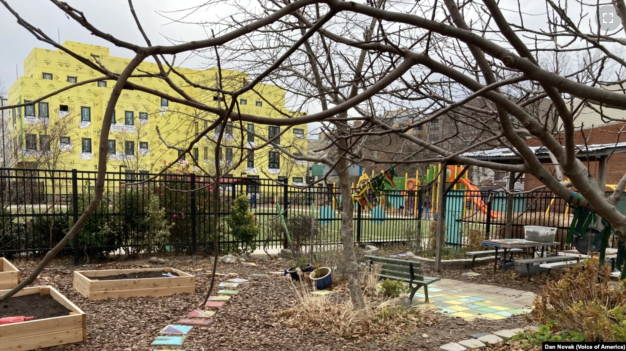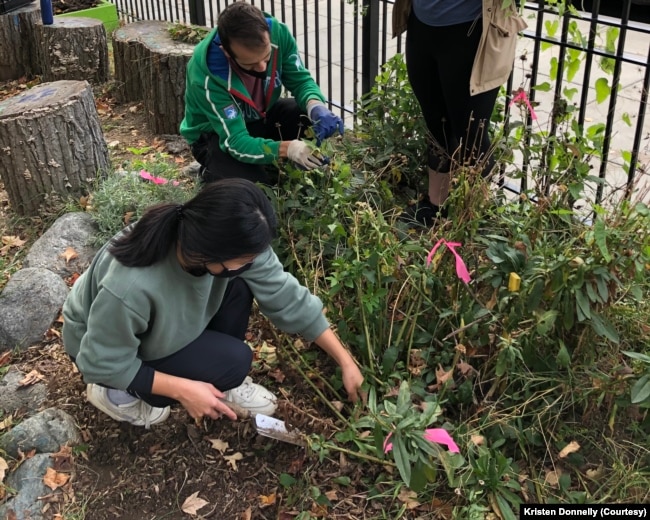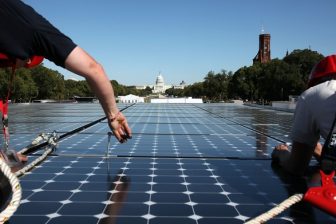
Green spaces introduced for ‘city kids’ across Washington
A big city might not seem like the best place to learn about nature and the environment. But one group in Washington, D.C. is trying to change that.
City Blossoms is a non-profit organisation with the goal of bringing nature to children who might not otherwise have green spaces. The organisation has assisted in creating green space at seven elementary schools, two high schools and 18 early childhood centres across Washington D.C.
City Blossoms has its own educators who teach children lessons centred on gardening and nature, writes Dan Novak. Tara McNerney is the director of City Blossoms and a former teacher. She said City Blossoms’ lessons centre on environmental science, healthy living skills like cooking, and artistic expression.
In the garden, students can learn environmental ideas like plant lifecycles or ecosystems. But teachers can also use the green space for reading lessons by reading a garden-related book or learning nature vocabulary. Even math could be taught in the garden. “We’re really able to adapt into the subjects that the teachers are wanting to teach,” McNerney said.
‘Every garden takes the shape of the community’
City Blossoms’ partnerships with local schools are meant to last at least three to four years. City Blossoms assists schools in creating and caring for the garden. But the gardens are mainly operated by the schools. McNerney said she partners with schools that already understand the importance of an outdoor education and that want to keep the garden at the school for many years.
“It’s a school-run program that City Blossoms is supporting,” McNerney said. “We don’t want it to be a ‘plop and drop’ garden where it’s seen as a City Blossoms garden and it’s not fully embraced by the community, because that won’t really lead to a sustainable garden program.”
In City Blossoms’ five other community gardens, the organisation supports the garden and provides nature activities for the community. But the spaces remain community-driven.
“At the end of the day, we’re not designing these sites,” said Isa Zambrano. She helps maintain the community spaces for City Blossoms. “The community designs it. Every garden takes the shape of the community and the culture that exists there.”
Young children and older adults have gotten involved with the community green spaces, said Kendra Hazel. She oversees the community gardens for City Blossoms. During cooking lessons, for example, people will tell about meals that are special to their culture.
The community gardens represent the diversity of D.C., Zambrano said. “It’s like putting pieces together of so many different people and cultures and neighbourhoods.”
Food deserts
Healthy food is hard to find in some parts of Washington, D.C., especially in poorer areas. About 15 percent of D.C. is a “food desert.” A food desert is an area where the nearest supermarket is more than 1.6 kilometres away. In the two poorest sections of Washington, D.C. — Ward 7 and 8 — there are just three supermarkets for 160,000 people.
Seven of City Blossoms’ gardens are in those two wards. Part of the organisation’s mission is to “grow in spaces that might not otherwise have green spaces, and might not have fresh, healthy food,” McNerney said.
For older students at two D.C. high schools, students learn how to grow and harvest crops through City Blossoms’ Mighty Greens program. Students in the program also sell their vegetables and herbs at local farmers markets.
‘Getting your hands dirty’
While City Blossoms’ main goal is to teach children, many older families and adults have also gotten involved. The organisation holds gardening lessons for all ages.
Hazel said the pandemic has made people want to spend more time outside experiencing nature.
“People have really woken up to the fact that green spaces are really important in our communities,” Hazel said. They have realised the good that comes from “being outside and being disconnected from technology, and just being,” she added. “And getting your hands dirty.”
By Dan Novak, VOA. Republished courtesy of learningenglish.voanews.com






